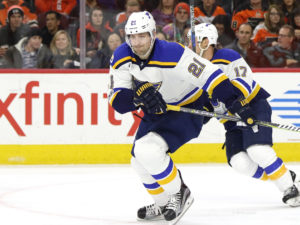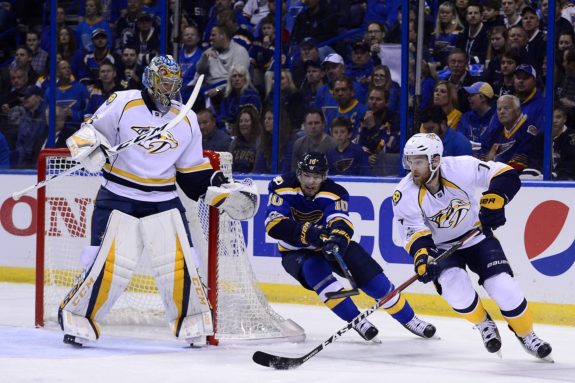The St. Louis Blues face a pivotal Game 4 tonight in the Music City against the Nashville Predators. Down 2-1 in the series, the Blues hope to shift momentum back on their side and head home for Game 5 Friday night tied at two games apiece.
To do that, they must respond to the Preds’ dominant performance in Game 3 on Sunday afternoon. The Blues were outshot 34-23 and went through a stretch of not registering a shot on goal for over 13 minutes. St. Louis was outworked in every facet of the game and now finds itself one loss away from a 3-1 hole.
Here are five keys to Tuesday’s crucial tilt:
1. Control the Dot
Winning faceoffs has been a pinnacle of the Blues’ offensive scheme in recent memory. They’ve been victorious in over 50 percent of their draws for the past six seasons, yet have been horrendous in the category this postseason. St. Louis is currently ranked dead-last in the playoffs (including teams who have been eliminated), operating at an efficiency rate of 42.7 percent.
The matchup against the Predators (the third-best team in faceoffs this postseason) has proven no different; the Blues have won 43.7 percent of draws through three games. In Games 1 and 3, Nashville controlled 62 percent. In Game 2, St. Louis controlled 55 percent. The Blues limited the Preds’ transition and zone time in the process, leading to their only win of the series so far.
Faceoffs don’t just affect even-strength play, but special teams as well. The Blues failed to win a draw when shorthanded (0/7) in Game 1. Nashville scored two power-play goals, which turned out to be the difference in the opening game of the series. On the man-advantage this series, the Blues have only won 40 percent (6/15). In Game 4, expect a better outing from Mike Yeo’s club in this regard.
2. Stay at Five-On-Five
Speaking of even-strength play, St. Louis has out-chanced the Predators at five-on-five or four-on-four at various points of the series. In Game 2, the Blues didn’t surrender a single power play for the Predators. They only took one minor penalty, which was Patrik Berglund’s interference on Ryan Ellis in the third period. But, 14 seconds after the coincidental penalties expired, Vladimir Tarasenko scored the eventual game-winning goal late in the third period.
The Blues have to stay out of the box in Game 4, plain and simple. Even when they kill off penalties, they’re only tiring out their own troops. And by losing faceoffs on the PK, it’s allowed Nashville to spend a heavy amount of time in the Blues’ zone. The opening goal in Game 3 was representative of this. Three seconds after Ryan Reaves’ penalty expired, Ryan Ellis ripped one from the point through Jake Allen. St. Louis never got possession at the end of the kill and was scrambling to clear the zone as a result.
One of the reasons why the Blues defeated the Minnesota Wild in five games was due to their smothering defense at even strength. Alex Pietrangelo and Co. limited the Wild to only four even-strength goals throughout the series. In three games, St. Louis has given up seven against Nashville. The Blues are at their best when they are at five-on-five. They’ll have to be at their best to fend off Nashville in a raucous Bridgestone Arena tonight.
3. Production From the Bottom Six

The bottom two forward lines provided relief for the Blues during the regular season when Jaden Schwartz, Alexander Steen, and even Tarasenko went through their respective goal droughts. Berglund scored a career-high 23 goals in the 2016-17 campaign while free agent “re-acquisition” David Perron added 18 (and 46 points overall).
So far in the postseason, neither of them have found the net. Against Nashville, the duo has combined for a mere five shots on goal in three games. When Berglund signed a five-year, $19.25 million contract in late February, the organization was rewarding him for a solid year offensively.
Now, it’s his turn (once again) to prove himself worthy of the money and finally break through on the scoresheet before it’s too late. Perron is in the opening year of a two-year, $7.5 million deal he signed on July 1. St. Louis leaned on them at times to get through rough stretches in the regular season. Their contributions are pivotal if the Blues are going to advance further.
In order to win the Stanley Cup, you’ll need heroic performances from even the most unlikely sources. Fourth-liners Vernon Fiddler and Cody McLeod have the two game-winning-goals for the Predators this series. St. Louis’s fourth-liners have registered only one assist combined.
The trio of Ryan Reaves, Kyle Brodziak, and Scottie Upshall was one of the most offensively-gifted energy lines in the NHL this regular season. At the very least, they need to start generating solid chances and cycle the puck in Nashville’s zone. A goal from them could open the floodgates for the rest of the team.
4. Quick Shifts
Roman Josi’s goal with 5:49 left in the third period added some timely insurance to a Predators one-goal lead in Game 3. It was a back-breaking blast from the point that Jake Allen never saw. What did that goal result from?
First, Colton Parayko played the puck back to Joel Edmundson in the Blues end with 7:13 left. Edmundson then fanned on a pass around the net. The Nashville forecheck (led by Viktor Arvidsson) picked up the puck with 7:08 on the clock and didn’t lose possession of it until Josi’s shot hit the twine.
St. Louis could not change during this interval of time, but Nashville did. Twice. Fifty/fifty battles have become a problem for the Blues in this year’s playoffs. It began against Minnesota and continues in Nashville. Several of their goals allowed have come from turnovers in their own zone, which is inexcusable at this time of year.
Quick line changes are essential to keeping fresh bodies on the ice during a series as physically grueling as this one. Mike Yeo has repeatedly kept his players’ shifts around 45-50 seconds. Despite this, there are certain times when the Blues are hemmed in their own zone and are forced to ice the puck. Knowing their faceoff success (or lack thereof), this presents an obstacle. It can be all be avoided, though, by making smart decisions in their defensive zone for easy outs.
5. Play With a Lead
Playing from behind is never an easy task, especially in an opposing building. The Blues learned that lesson the hard way in Game 3. In fact, St. Louis has only led for 3:51 in the series, which was during Game 2 after Tarasenko’s second goal. Last series against Minnesota, it was the Blues who led for a majority of the series. They also scored the opening goal in four of the five games (and won those four).
This time around, the Predators have scored first in all three games, which plays directly into their defensive setup with the 1-4 neutral zone trap. It’s tough to sustain offense against their “Big Four” on defense (Mattias Ekholm, P.K. Subban, Ellis and Josi) when trailing. St. Louis scoring first would force Nashville’s D to become more active, both on the rush and in the offensive zone along the walls.
The onus then falls on the Blues to transition the puck up the ice using a stretch pass or a flip-out. There’s been a handful of odd-man rushes for the Blues in this series, but drawing first blood would open up more chances to catch the Predators on their aggressiveness. Inserting quicker players into the lineup like Magnus Paajarvi can help in this area, too.
St. Louis can’t afford to chase Nashville around the ice for 60 minutes in Game 4. They need to dictate the pace early and apply relentless pressure in all three zones if they want to have a chance at evening the series.
